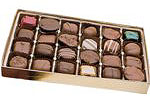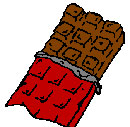 The creation of this confection istediousandtime-consuming, and has both a sweet and abittersweetending. Initially, skilled workers cut ripe cacao bean pods from the cacao tree, split them open, andscrapeout thepulpcontained inside. After the mass of pulpfermentsfor a few days, workmen spread it in the hot sun to dry, separate the dried seeds from the remainder of the pulp, and bag them for shipment to the market. The creation of this confection istediousandtime-consuming, and has both a sweet and abittersweetending. Initially, skilled workers cut ripe cacao bean pods from the cacao tree, split them open, andscrapeout thepulpcontained inside. After the mass of pulpfermentsfor a few days, workmen spread it in the hot sun to dry, separate the dried seeds from the remainder of the pulp, and bag them for shipment to the market.
Once the bagged seeds arrive at their destination, the manufacturer's processing mill, they are cleaned to remove foreign material. Next, they areroasted, to loosen theirhusks, which are then literally blown away in yet another process. Finally, the inner kernelof the seed is broken into bits called "nibs." At this juncture, the road in the chocolate making processforks, as what is done next with the nibs determines the final product. kernelof the seed is broken into bits called "nibs." At this juncture, the road in the chocolate making processforks, as what is done next with the nibs determines the final product.
When the nibs are ground under heavy stone mills, the oil within the nibs is released, and transforms the mass into "chocolate liquor," a thick substance which, uponhardening, produces the bitter chocolate used in recipes for baking and for candy-making. The method of producing sweet chocolate follows that of producing bitter chocolate, with theadditionof other substances, such as cocoa butter, a fat.
Workmen obtain cocoa butter, abyproductof the cocoa making process, by grinding the nibs, and by separating part of the fat from the resulting mass. Not only is cocoa butter an essential ingredient in producing sweet chocolate, but also in producingcosmeticsand medicines. Once the cocoa butter is extracted for its various uses, the remaining mass is finely, and finally, ground to produce cocoa.
Cocoa, the drink, is the mother of all chocolate making. The ancientAztecsprepared the original version of this beverage by crushing cacao beans, which they boiled with water and various spices, seasoned with pepper, and served cold.
Spanish explorers, who stumbled upon thispotentAztec drink, stole the recipe, deleted the pepper from it, and substituted an equal measure of sugar to the crushed cacao beans and water before boiling it. The Spaniards successfullysquirreledaway their new and improved drink recipe for almost 100 years until, in the mid 17th century, a Frenchman found sweet success by discovering the art of making solid chocolate from finely ground cacao beans.
|
tedious:单调乏味的
time-consuming:花费大量时间
bittersweet:苦乐参半的
scrape:挖
pulp:果肉
ferments:发酵
roasted:烘干
husk:外壳
kernel:核
forks:分岔
hardening:硬化
addition:添加物
byproduct:副产品
cosmetics:化妆品
Aztecs:阿芝台克人
potent:功效强大的
squirrel:贮藏
|